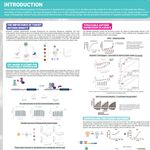Postgraduate Student, University of Manchester
BIOGRAPHY

OCT 31, 2019 9:00 AM PDT
Investigation of Endothelial Cell Viability and Growth on 3D printed GelMa Vascular Networks
Sponsored by: Thermo Fisher Scientific/Gibco
Speaker
Event Date & Time
DATE: October 31, 2019
TIME: 9:00am PDT, 12:00pm EDT
Abstract
INTRODUCTION:
A major limitation for the development of 3D engineered tissues is the absence of viable and perfusable vasculature [1-3]. As a precursor to vascularized adipose tissue, cylindrical channels were formed in a cast gelatin methacrylate (GelMA) construct by printings sacrificial networks of Pluronic F127. Human umbilical vein endothelial cells (HUVECs) were seeded and cultured within the 3D printed channels, while Adipose derived stem cells (ADSCs) were cultured in the GelMa prior to casting the 3D printed channels.
The hydrogel was characterized by NMR, surface tension, contact angle and DMA. Pluronic filaments were printed onto glass slides using a robotic printer . HUVECs were cultured on GelMa substrate, whilst ADSCs were embedded within the GelMa. Live/Dead and Alamar Blue assays were used to assess the cells’ viability and proliferation respectively. Phalloidin staining was used to assess actin cytoskeleton organization.
RESULTS:
Once methacrylation has occurred NMR peaks are seen at 6ppm and 2ppm corresponding to lysine and methacrylated grafts of hydroxyl groups. Viability assays confirmed that HUVECs and ADSCs were viable after 48 hours. Alamar Blue data indicated an increase in cell metabolism over a 7-day period. Phalloidin staining demonstrated good organization of the actin cytoskeleton of HUVECs on GelMa. Data on HUVECs injected within the printed 2D networks and 3D culture of ADSCs within the GelMa matrix will also be presented.
DISCUSSION & CONCLUSIONS:
Collectively, our data illustrate that HUVECs could potentially grow and fully line the printed networks.
Learning Objectives:
- Explain what vascularisation is
- Review what hydrogels and scaffolds are and how they are used
- Describe the use of 3D printing and how it can help with tissue regeneration
Webinars will be available for unlimited on-demand viewing after live event.
LabRoots is approved as a provider of continuing education programs in the clinical laboratory sciences by the ASCLS P.A.C.E. ® Program. By attending this webinar, you can earn 1 Continuing Education credit once you have viewed the webinar in its entirety.
You May Also Like
OCT 02, 2024 | 7:30 AM
De novo gene synthesis and protein expression are established technologies that can give access to nearly any target DNA or protein sequence, allowing for engineering of biologics. In this p...
Speaker:
Claudia Chiocchini
Presented at: Cancer Research & Oncology Virtual Event Series 2024
Sponsored By: Thermo Fisher Scientific
Sponsored By: Thermo Fisher Scientific
DEC 10, 2024 | 9:00 AM
To-date, proteomic analysis has been severely limited in scale and resolution. Analyzing protein samples using an intact, single-molecule approach holds th...
APR 21, 2025 | 1:00 PM
C.E. CREDITS
Routine coagulation assays are widely performed in laboratories and provide valuable information to the patient’s overall clinical picture. It’s important for laboratorians to kn...
Speaker:
Malissa S Norfolk, MBA, PMP, MLS(ASCP)ᶜᵐSHᶜᵐ
FEB 25, 2025 | 1:00 PM
C.E. CREDITS
Quality efforts in the clinical laboratory are always under the microscope- a hyper-focus for laboratorians from start to finish. Recognizing the external factors that affect hemostasis test...
Speaker:
Rae Kerlin, BS, MLS (ASCP), NCA
MAR 19, 2025 | 11:30 AM
Join this year's poster presenters in the Poster Hall during the Poster Networking Hour, Wednesday, March 5th, from 10:00 –11:00 AM PDT , to chat...
OCT 31, 2019 9:00 AM PDT
Share
Investigation of Endothelial Cell Viability and Growth on 3D printed GelMa Vascular Networks
Sponsored by: Thermo Fisher Scientific/Gibco
Loading Comments...
Please update your information
Certificate of Attendance
Thank you for choosing Labroots. Please note that a Certificate of Attendance does NOT count towards Continuing Education Credits.
DOWNLOAD CERTIFICATE
DOWNLOAD CERTIFICATE
You must watch the entire webinar to receive your certificate of attendance.
You must attend the event before receiving your certificate of attendance.
You must register for the event first.
Certificate is no longer available for this event.
You must be logged in to retrieve your certificate.





